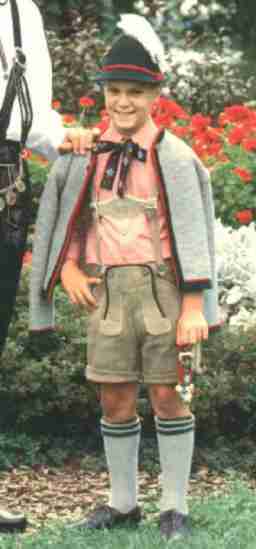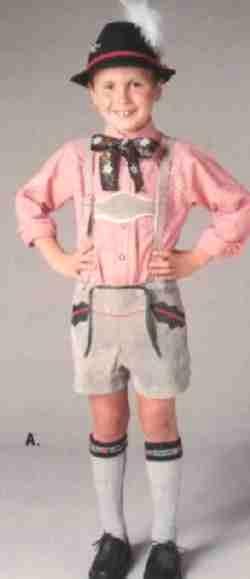
Figure 1.--American boys occasionally wear lederhosen, most commonly at ethnic events. Note how these lederhosen are a bit long, so the boy has turned them up to form a cuff.


Figure 1.--American boys occasionally wear lederhosen, most commonly at ethnic events. Note how these lederhosen are a bit long, so the boy has turned them up to form a cuff. |
American boys did not commonly wear short pants in general and it
was even less common to wear lederhosen. They were, however, occasionally
worn by some boys. It was less common for American boys to wear them
with kneesocks, except as part of ethnic events.
HBC contributors have reported American boys wearing lederhosen on a
number of occasions. One boy was noted wearing lederhosen at
Disney World in 1998. The boy was not from Europe, though. He
appeared to be just a little boy who's parents obtained a pair of
lederhosen from somewhere, and dressed him in them for a day at the
park. He was about 8 years old.
American boys might wear lederhosen under the following circumstances:
Some boys had lived in Europe and brought them back with them. This
is especially true of boys whose families were sent by companies and thus lived in German comunities. This is particularly the case when the family had German or other foreign relatives.
Some American families visiting Europe may have purchased lederhosen
for their children. Again this was most likely if they were visiting
local discendents.
Some older American boys participated in student exchanges. Boys
participating in these exchanges during the 1950s and 60s were
particularly likely to bring lederhosen home.
Some German-American families brought lederhosen for their children. One of the images on this page shows lederhosen being marketed to
German-Americans or others interested in German-oriented merchandize.
German's are one of the most numerous immigrant groups and scattered all over America. Some particularly large German communities exist in the big industrial cities like Cleveland, Pittsburgh, Bufalo and others.
Lederhosen were most commonly worn at ethnic
festivals like October-fests. Some boys participating in German bands
also often worn them.
The tracht or etnic costumes vary from group to group. Tracht
comes from the word Tragen meaning "to wear." Thus, Tracht means
that which one
wears. In the more narrow context of a Gauverband, it means the
garments worn to
represent and preserve a particular time period in Bavarian/Tirolean history
and a particular community standing. That time period is generally the
mid- to late 1800's; Tracht has, however,
undergone minor changes since that time. The community standing is that
of rural folk in the mountainous regions. At one time, the Tracht, or
clothing worn, was an individual's choice of colors, fabrics, metals, etc.
As the regional Tracht began to fade in the late 1800s in rural Bavaria, Vereine formed for the specific purpose of preserving the Tracht and other parts of the heritage (song, dance, and dialect). The Vereine have made the Tracht more uniform, i.e., all members wear the some color ties, skirts, Spenser, socks, etc., but the details of the Tracht, such as jewerly or lace patterns, are left to the individual's choosing.

Figure 2.--This boy models lederhosen from a catalog offering German merchandise to German-Americans. |
Boys in bands are not the only American boys to dress up in
lederhosen. An HBC contributor reports a boy of about 15 years
participating in a New Jersey parade. His father made a living by
providing geese that actually walked in a flock for parades. The boy
and his sister, from the time they were little, were dressed in
typical dress. For the boy, it was lederhosen. His dad said that now
that he was fifteen, his son was getting more and more self concious
about being in the parade dressed in lederhosen, and was trying to
phase himself out.
Personal accounts of boys and lederhosen are as follows:
Navigate the Boys' Historical Clothing Web Site:
[Return to theMain lederhosen page]
[Return to theMain short pants page]
[Introduction]
[Chronology]
[Clothing styles]
[Biographies]
[Bibliographies]
[Countries]
[Activities]
[Contributions]
[Boys' Clothing Home]
